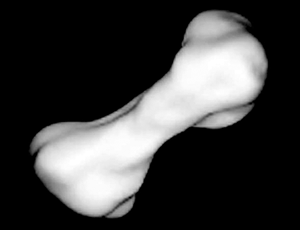Asteroid Coming? Not To Worry…This Time
Nov. 7, 2011
In the closest approach of any asteroid since 1976, a space rock known as 2005 YU55 will whiz past Earth inside the orbit of the moon on Nov. 8, 2011, at a speed of 30,000 miles per hour (13 kilometers per second). The asteroid, a dark, slowly spinning object about 1,300 feet (400 meters) wide, will pass no closer than 201,700 miles (324,600 kilometers) to our planet. The moon follows an orbit that is an average of 238,897 miles (384,467 kilometers) from the center of Earth. Asteroid 2005 YU55 is a regular visitor to the inner solar system, but it has not come this close to Earth in 200 years. Another asteroid this large will not approach Earth until 2028, according to scientists at NASA.

The asteroid Kleopatra ranks among the most oddly shaped asteroids. It has a "dog bone" shape, with two rounded knobs connected by a slender center. NASA/JPL/NSF/Arecibo Radio Telescope
Scientists planned to track 2005 YU55 using NASA’s Deep Space Network, a group of satellite tracking stations in California, and the radio telescope at the Arecibo Observatory in Puerto Rico. The Arecibo telescope captured a fuzzy image of the asteroid in 2010, when the space rock was 1.5 million miles (2.3 million kilometers) away. Scientists also hope to learn if the asteroid contains ice or minerals holding water.
The asteroid was not expected to have any detectable gravitational effects on Earth’s tides or tectonic plates, which are affected by the moon. Nor will the asteroid hit the moon, which will be more than 150,000 miles (240,000 kilometers) away as the asteroid makes its closest approach to Earth. An official with NASA’s Near-Earth Object Program Office noted that an asteroid about the size of 2005 YU55 crashes into Earth only about once every 100,000 years. If an asteroid this size were to hit Earth, it would dig a crater 4 miles (6.4 kilometers) wide and 1,700 feet (518 meters) deep.
Additional World Book articles:


